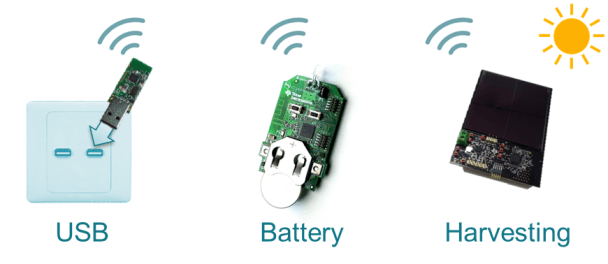SWRA475A January 2015 – October 2016 CC2540 , CC2540T , CC2541 , CC2541-Q1
2.6 Power
A beacon can be powered using several methods. There are three different main approaches:
- DC power supply (USB, Mains, and so forth)
- Batteries (CR2032, AAA, Lithium, and so forth)
- Energy harvesting (Solar, kinetics, and so forth)
Typically, the primary choice is batteries that allow small and low-cost product designs while still maintaining a lifetime suitable for most applications. It is also possible to use re-chargeable batteries and in some applications together with wireless charging. The choice of battery type is important because some batteries might be sensitive to high peak currents. The amount of capacity needed is based on how often broadcasting is necessary, and if any further processing is required (sensor interaction, algorithms, and so forth). Sensor interaction typically involves serial communication using UART, SPI or inter-integrated circuit (I2C) that adds a power consumption overhead, which may be greater than the Bluetooth low energy protocol alone.
 Figure 5. Power Options
Figure 5. Power Options If the design is powered by DC power supply, the assumption would be that the power consumption is no critical parameter. If it is still critical, the approach would be the same as for a battery powered design.
Energy harvesting is being introduced more into low-power wireless solutions and a beacon can be powered by energy harvested sources. Mechanical pressure, fresh fruit and solar power are commonly known sources and even indoor light [4] can be used to power a beacon.